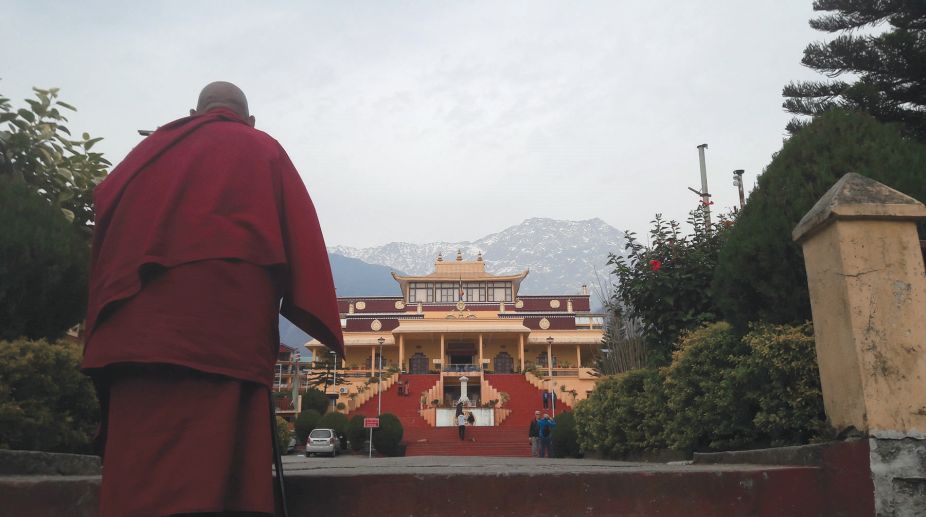Nestled in the picturesque charm of Dharamsala, the Gyuto monastery leaves an unforgettable impression on visitors, especially tourists, who have become its emissaries, touting it as a ‘must visit’ place.
The monastery is marked by the magnificence of Tibetan architecture and the use of propitious symbols and brightly coloured flags. It is an ancillary of one of the most famous monasteries in eastern Tibet, the Gyuto Tantric Monastery, that was founded by Jetsun Kunga Dhondup , the main disciple of the first Dalai Lama, in 1474. After the Chinese invasion in 1959, the monastery was re-established in Dharamshala.
Advertisement
At a distance of eight km from Dharamshala, the Gyuto monastery is located at Sidhbari on the main road to Palampur. It specialises in the study of tantric meditation, tantric ritual arts and Buddhist philosophy. While it is a pilgrimage site for the followers of Buddhisim, for tourists from across the globe it is a site that thrills them.
The monastery was constructed to accommodate over 500 monks. “Since the Gyuto monastery was re-established in India, the monks have been able to maintain their practices and traditions, even improving some of them. The monks of Gyuto have not only preserved the traditions but have attracted respect and interest from across the world,” said Gyuto Abbot.
“This temple of Gyuto Tantric University (The Second Ramoche Temple of Tibet) was constructed with the financial support of Bentenshu, Japan, on December 10, 1989. The Japanese built the new monastery in the lap of the Himalayas to celebrate the Nobel Peace Prize won by His Holiness, the Dalai Lama,” said a Gyuto monk.
The heart-touching history associated with the monastery is known all over the world, he said, adding that it has always depicted how tantric meditation and tantric arts can be used for the well-being of common folk.
The main complex of the monastery on the hilltop offers a spectacular view of lush green fields and the ice-clad Dhauladhar mountains in the backdrop.
A majestic statue of the Sakhyamuni Buddha inside the monastery glistens and spreads a rich golden hue everywhere. “The time spent in the monastery with a glimpse of the idols and other sculptures is a soul-satisfying feeling. The place is so captivating that one is able to connect with the inner self and also feel the positive vibrations in the ambience,” said Pragya Laha, a tourist.
The backdrop of beautiful mountains adds to the charm of the place. Those visiting Dharamsala must include it in their itinerary, she suggested.
“This beautiful monastery is an abode of peace and is one of the popular tourist attractions in Dharamshala. I love to visit it on weekends. It serves as a sacred break from my busy schedule. One can meditate in silence and seek the blessings of Lord Buddha. Also, one can enjoy a small walk around the monastery.’ said a local resident, Shubham Bhatia.
This monastery is a mix of spirituality and earthen reality, reflecting ancient culture but also showing the use of modern architecture. Gyuto school, Gyuto library and Gyuto clinic are located within the Gyuto Monastery complex .
” Gyuto school was founded with an aim of enriching young monks and others pursuing studies in advanced Buddhism, with traditional education while making sure they become part of the modernised world. Also, the Gyuto library consists of works of all renowned Indian and Tibetan masters to meet the needs of students with modern education,” said a Gyuto faculty member.
“The number of visitors has increased and day-by-day it is multiplying. Gyuto Monastery is mostly visited at the time of Buddha Purnima as during that festival it is decorated to the hilt, showcasing the colourful Tibetan culture and delicious Tibetan food,” said a shop owner in Sidhbari , Alok Sharma.
The Gyuto Tantric Monastery has got a powerful religious and historical significance and has been able to spread ancient knowledge of tantric texts, meditation, rituals and arts worldwide.











